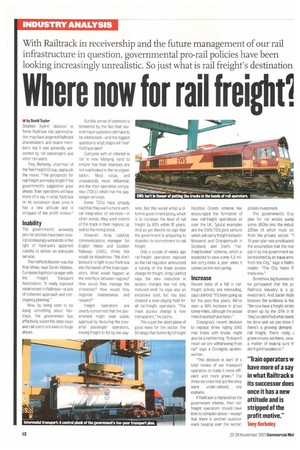Where now for rail freightl
Page 12

If you've noticed an error in this article please click here to report it so we can fix it.
With Railtrack in receivership and the future management of our rail infrastructure in question, governmental pro-rail policies have been looking increasingly unrealistic. So just what is rail freight's destination
• by David Taylor
Stephen Byers' decision to force Railtrack into administration may have angered Railtrack shareholders and board members, but it was generally welcomed by rail passengers and other rail users.
Tony Berkeley, chairman of the Rail Freight Group, applauds the move: The prospects for rail freight are really bright if the government's suggestion goes ahead. Train operators will have more of a say in what Railtrack or its successor does once it has a new attitude and is stripped of the profit motive,"
Inability
The government's avowedly pro-rail policies have been looking increasingly unrealistic in the lot of Railtrack's apparent inability to deliver an adequate service.
The Hatfield disaster was the final straw, says Sarah Watkins, European logistics manager with the Freight Transport Association: "It really exposed weaknesses in Railtrack—a lack of coherent approach and contingency planning."
Now, by being seen to be doing something about Railtrack, the government has effectively wiped the slate clean and rail users are keen to forge ahead.
But this sense of optimism is tempered by the fact that several major questions still have to be addressed—and the biggest question is what shape will 'new' Railtrack take?
Everyone with an interest in rail is now lobbying hard to ensure that their interests are not overlooked in the re-organisation, Most vocal, and undoubtedly most influential, are the train operation companies (TOCs) which run the passenger services.
Some TOCs have already said that they want a more vertical integration of services—in other words, they want control of the track in their regions, as well as the rolling stock.
However, Andy Lickfold, communications manager for English Welsh and Scottish Railways (EWS), thinks this would be disastrous: "We don't believe it is right to put Raittrack into the hands of the train operators. What would happen at the interface between regions? How would they manage the crossover? How would they organise maintenance and repairs?"
Freight operators are clearly concerned that the government might seek public approval by favouring the powerful passenger operators, leaving freight to fall by the way
side. But this would entail a Uturn in government policy, which Is to increase the level of rail freight by BO% within 10 years. And as yet there's no sign that the government is preparing to abandon its commitment to rail freight.
Only a couple of weeks ago rail-freight operators rejoiced as the rail regulator announced a halving of the track access charge for freight Andy Lickfold says the new reduction in access charges has not only reduced what he says was an excessive cost, but has also created a level playing field for all rail-freight operators. "The track access charge is now transparent," he claims.
This is just the latest piece of good news for the sector. The Strategic Rail Authority's Freight Facilities Grants scheme has encouraged the formation of new rail-freight operations all over the UK. Typical examples are the EWS/TDG joint venture which will carry freight between Mossenci and Grangemouth in Scotland, and Exel's "railfreightonline" scheme, which is expected to save some 4.5 million lorry-miles a year when it comes on line next spring.
Increase
Recent tales of a fall in railfreight activity are misleading, says Lickfold; "It's been going up for the past five years. We've seen a 40% increase in gross tonne-miles, although the actual miles travelled have fallen."
Consignia's recent decision to replace three nightly EWS mail trains with trucks might also be a red herring. "It doesn't mean we are withdrawing from rail" says a Consignia spokeswoman.
"This decision is part of a total review of our transport operation to make it more efficient and more green." The three services that got the chop were under-utilised, she explains.
If Railtrack is replaced as the government intends, then railfreight operators should have little to complain about—except that there is another question mark hanging over the sector; private investment.
The government's 10-y( plan for rail entails pump some L6Obn into the indust 130bn of which must no from the private sector. 'I 10-year plan was predicated the assumption that the mar put in by the government wo be matched by an equal amo from the City," says a Railtrl insider. "The City hates R track now."
Somehow, big business m be persuaded that the pc Railtrack industry is a gc investment, And Sarah Watk believes the evidence is the "We now have a freight strate drawn up by the BRA in IV They've identified what needs be done and we can show tl there's a growing demand rail freight. There really green shoots out there...now a matter of making sure ft don't get trampled on




















































































































































